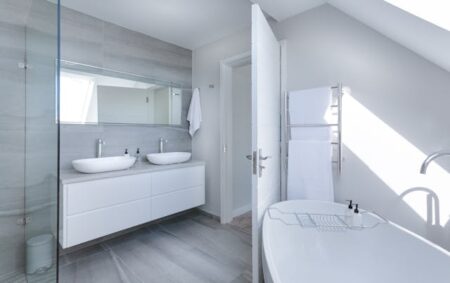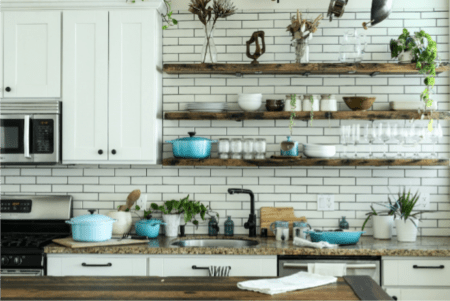Tiles are arguably the most versatile decorative elements in any home. They are a guaranteed way of achieving incredible, long-lasting results when creating a stylish, impressive aesthetic.
Tiles come in various colors, materials, textures, and sizes. Choosing a tile for your remodeling project can be daunting, especially if you don’t know what you’re looking for.
Here’s a definitive guide to the different types of tiles and their uses.
- Ceramic Tiles
Ceramic tiles are amongst the most popular types of tile in the home. These tiles are highly durable and versatile, making them perfect for every room in the house. Ceramic tiles are easy to install and clean. Additionally, they are available in hundreds of design patterns, colors, and textures.
High-quality ceramic tiles have a rugged, solid surface made from silica and clay treated at high temperatures. The material is also resistant to moisture, is durable, and slip-resistant.
Best for: Bathroom Walls
There are different types of ceramic bathroom tiles. You can have earthenware, glazed, unglazed, terracotta, and vitrified options.
Consider using glazed tiles for your upcoming bathroom remodeling project. Ceramic provides better protection against stains and damage than natural stone or glass tiles.
- Porcelain Tiles
Porcelain is a robust and dense tile with superior durability. It is a type of ceramic, but the materials and the temperature used during production differ. Porcelain tiles contain feldspar, white clay, quartz, and kaolin heated at extreme temperatures.
The resulting product is a material that is more durable and stronger than the typical clay ceramic tile. Porcelain tiles are resistant to abrasion, moisture, and chemical damage. You can choose from various patterns, sizes, styles, and colors.
Best for: Outdoor Patio Area
Porcelain’s exceptional durability makes it a good candidate for areas that receive high foot traffic. You can consider using the sturdy porcelain tile for your outdoor patio area. The tile is impervious to water, frost-proof, and offers an anti-slip finish.
- Granite Tiles
Few materials can match the opulence and grandeur associated with granite. The natural rock tile contains unique specks, flecks, and venation, producing beautiful patterns.
Granite tiles come from igneous rocks formed during the cooling of lava and magma. The stones are quarried and cut into thinner pieces, with the slabs sold in home improvement stores.
Granite tiles offer a variety of styles, colors, and pigmentation. However, granite may require frequent sealing to improve its water resistance and anti-bacterial properties.
Best for: Kitchen Countertop
Granite tile may be perfect for a kitchen remodel. You can use the slabs to create an island countertop.
The tile is heat-tolerant, so you can place a hot pan on the surface without worrying about scratches or stains. Sealed granite tiles are also easy to clean and maintain, making them a fantastic choice for wet areas.
- Glass Tiles
Glass tiles are quickly becoming a popular option for homeowners. The tile slabs reflect light, brightening any walls they are installed on. You can find glass tiles in virtually any color, making it easier to match any theme in your home.
The tile is made from recycled glass material, with the desired color pigments added during its molten state. The hue on your glass tiles may never fade, maintaining its brilliance for decades.
Best for: Glass Tile Mirror Frame
The tile is an ideal choice for a bathroom wall. You can use the shiny slab to create a glass tile mirror frame above your vanity closet. The iridescent sparkles of the decorative tiles make your small bathroom appear brighter and larger.
- Stone Tiles
Granite may not be the only natural stone available for tiling. You can explore other stone tile options, such as marble, limestone, travertine, and slate. Natural stones are porous, containing crevices and pores that make the tiles susceptible to stains.
You may need to pour a sealant every one to two years as part of your home maintenance routine.
That said, natural stone tiles have an unmatched aesthetic appeal. The streaks and venation vary from one tile to the next, and no two tiles can be precisely alike. The rough edges and finishes may add a rustic feel to your space.
Best for: Firepit
You can take advantage of the heat-resistant properties of natural stones to decorate your outdoor fireplace. The dull, textured edges may add interest to your backyard without being a distraction.
- Quartz Tiles
Quartz is a stone engineered to mimic the venation of natural stone. The slabs have a natural-looking profile and are considerably cheaper than granite or marble.
Quartz is a rigid material made from natural quartz, polyester resins, and color pigments. It ranks as the fourth hardest crystalline material on the Mohs scale, guaranteeing durability for years to come. Quartz slabs are also non-porous, making them easier to maintain.
Best for: Entryway
The durability of the tiles makes quartz a popular option for highly trafficked areas. You can use the engineered stone to create flooring for your entryways and corridors.
Conclusion
The world is full of various types of tiles for different purposes. It can be challenging trying to go through all the other options available. Ceramic and porcelain tiles may provide an all-rounded functionality. Also, natural stones offer the best aesthetic pull but are the most expensive option due to their high maintenance. The durability of quartz slabs makes them a popular choice for surfaces exposed to more wear and tear. Follow the tips above to find inspiration for your next renovation project.











